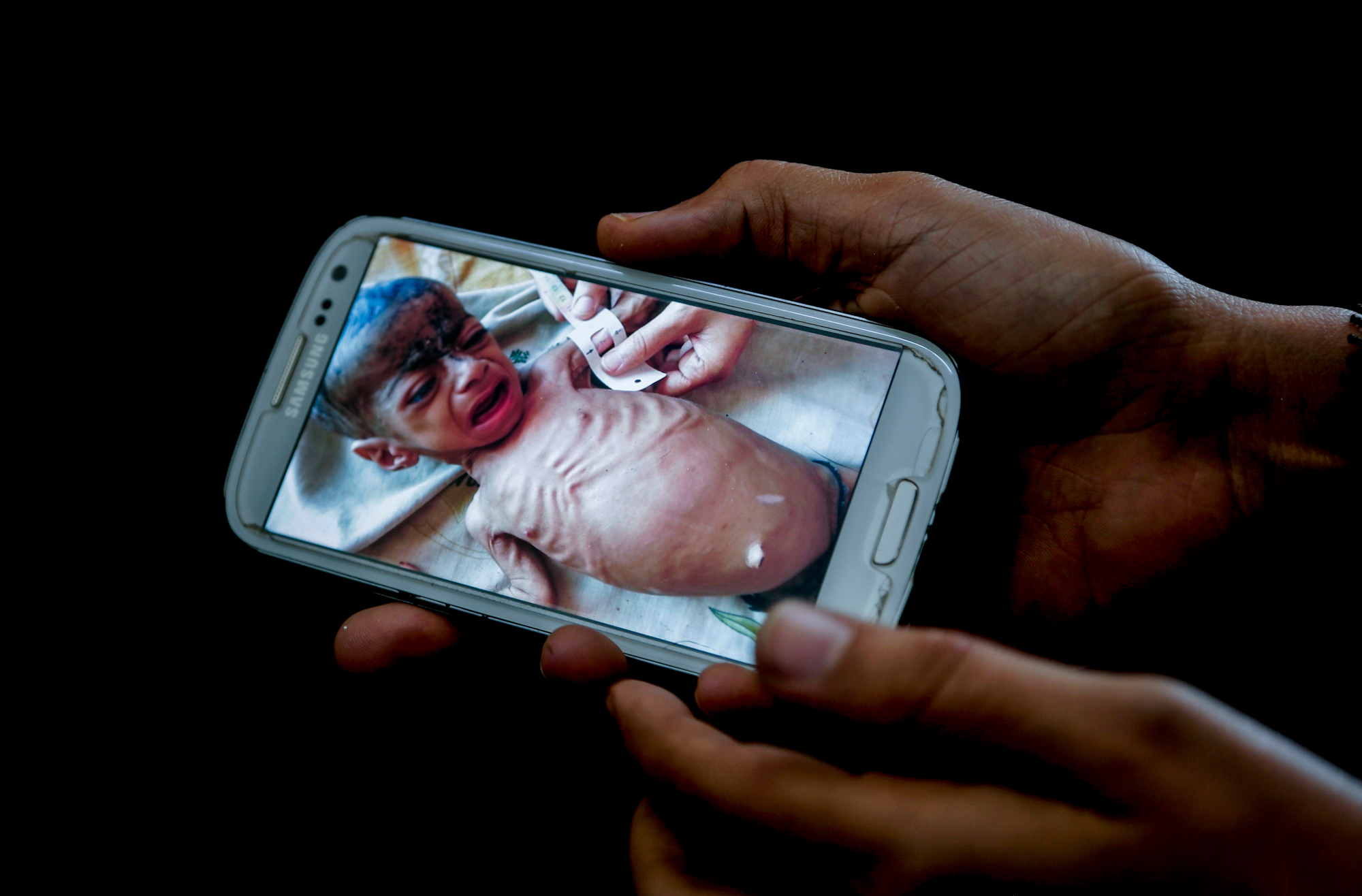HAJJAH, YEMEN — For almost three years, the expression “on the brink of famine” has been repeatedly cited by relief agencies to describe one side of the humanitarian disaster in Yemen. It is an expression that has never been revised, even as it became increasingly inaccurate as the Saudi-led coalition tightened its blockade and ignored the pleas of governments and human rights organizations. Now famine is will entrenched in Yemen and the expression “on the verge of starvation” has become obsolete.
A 45-year-old mother sits cross-legged on a bed in Aslam Hospital in Hajjah province, in northern Yemen, resting her two-year-old son, Mabrouk, on her knee, speaking in murmurs to her son whose ribs push out from underneath a fine layer of skin as his eyes stare wide from his gaunt face.
On the right side of a room filled with the sounds of crying children, five parents wait for their turn to weigh their children. They also suffer from the malnutrition that has spread in the remote area of Aslam and many other districts in Yemen over the past month. Their children’s bodies appear much too small for their ages.
According to Yemen’s local health sources, Aslam recorded one of Hajjah’s highest jumps in the number of malnourished children. Ebrahim al- Ashwal, the manager of Health Office in the province told MintPress that there were 17,000 cases of severe acute malnutrition in the first six months of 2018, higher than any month on record.
Mekkiya Mahdi, who heads the Aslam Health Center said: “We have received 14 to 17 cases of those suffering the most extreme form of malnutrition per week.” The Al-Thalouth Center (The Tuesday Center) is just one of the health centers in Aslam that receive dozens of cases each week.
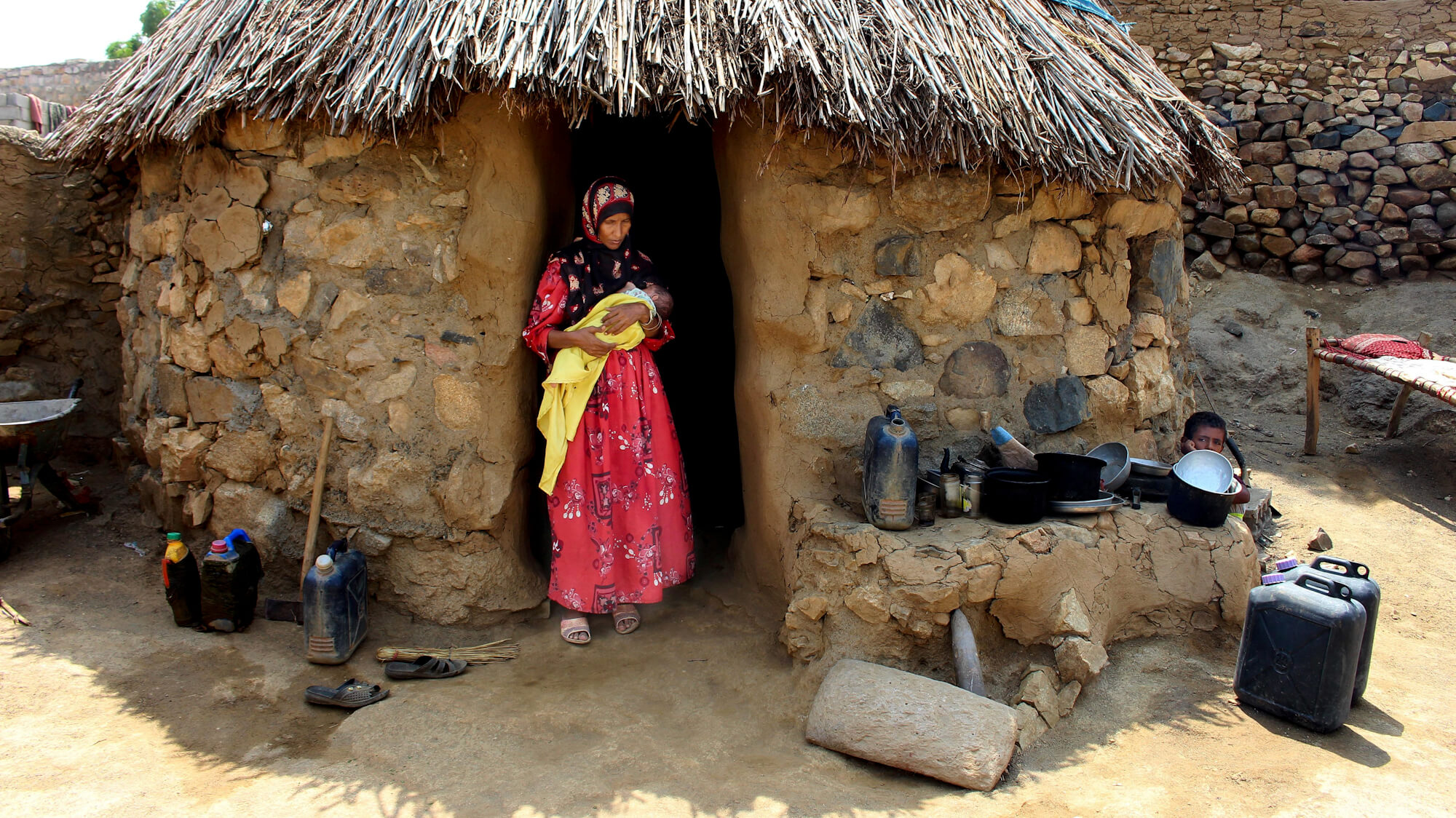
Amna Ali, who lost her 3-year-old Zaifa Shouib, to malnutrition-related illness, stands in front of her hut holding a baby in Hajjah, Yemen, Sept. 22, 2018. Hammadi Issa | AP
The Ministry of Health, based in Sana’a, said in a statement to MintPress :
Now, more than 2 million children have suffered from famine; one out of three children under the age of five in Yemen are already malnourished. There are eight out of nine children with anemia, and there are between one and two hundred girls or women of childbearing age who are malnourished.”
Save the Children warns that 5.2 million children in Yemen now face starvation. Last month, the organization predicted that at least 36,000 children in Yemen — an average of 1,600 children every day — will die from extreme hunger by the end of the year.
Symptoms of severe acute malnutrition — the most extreme and dangerous form of undernutrition — include jutting ribs and loose skin, with visible wasting of body tissue. Swelling in the ankles, feet and belly as blood vessels leak fluid under the skin are other symptoms. In Yemen, thousands of children bear these symptoms. Images of children with jutting ribs and swelling bellies have become the symbol of famine in Yemen.
Nothing to eat but leaves and pets
“Since the day he was born, I have not had the money to buy his milk or buy his medicine,” Mabrouk’s mother declares, as she feeds her entire family with a Halas mush made from leaves. “We eat leaves. I pick it, then wash and boil it into a sour, acidic green paste, then we eat it.” She herself is undernourished and is often unable to breastfeed her child.
Like the residents of Aslam, many Yemeni families have reportedly resorted to eating leaves in a desperate bid to stave off starvation. This was confirmed by Mark Lowcock, the United Nations under-secretary-general for humanitarian affairs, who told the Security Council last month:
We are already seeing pockets of famine-like-conditions, including cases where people are eating leaves because they have no other form of sustenance.”
The siege-and-starvation tactics employed by the Saudi coalition with the support of the United States have even pushed people to eat stray animals or their own pets to survive.
Saied Abdu is nearly five months old but has the bearings of both a premature baby and a grandfather. Hunger has ravaged his tiny frame and given him a bulbous head.
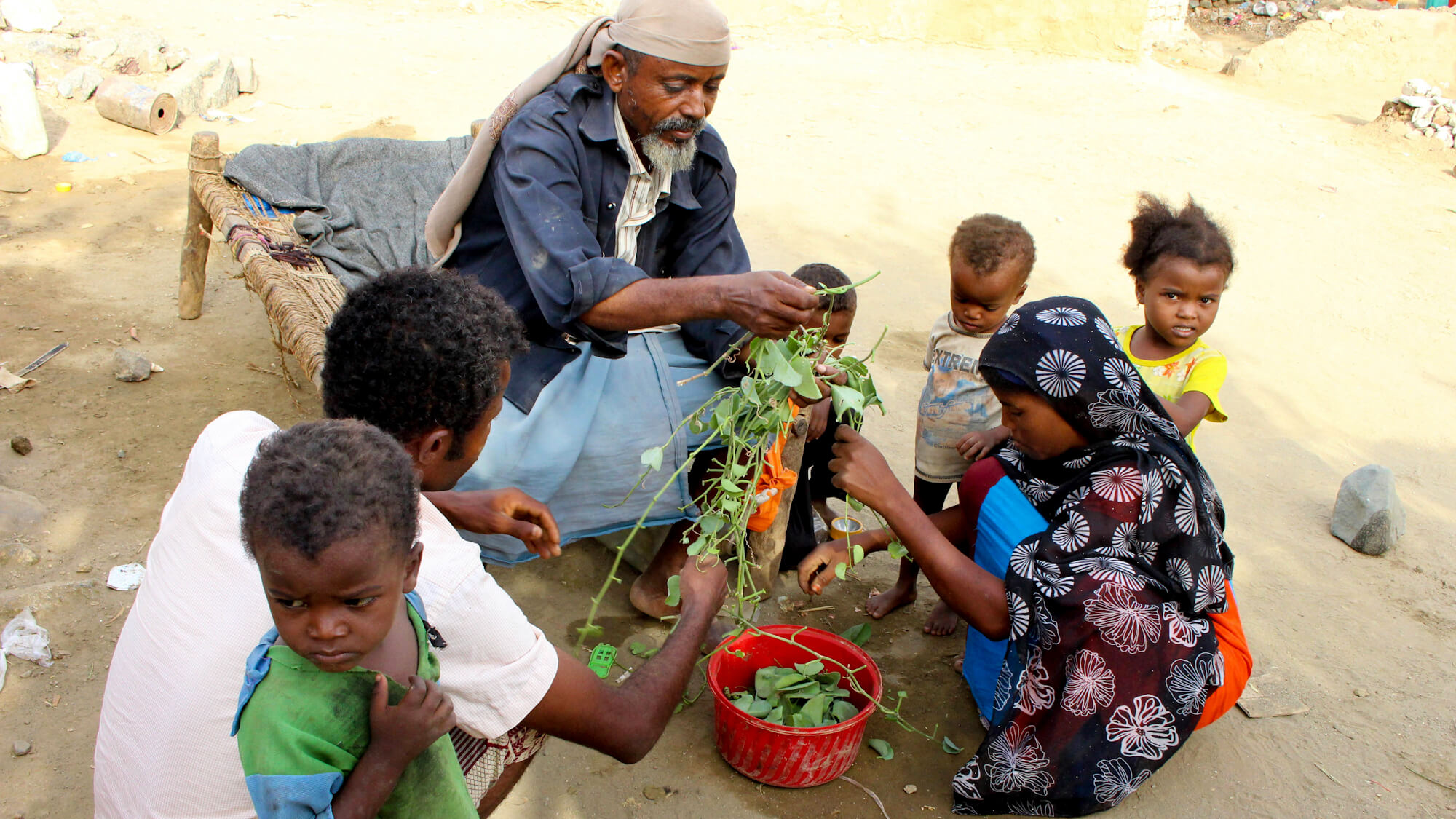
A man feeds children Halas, a climbing vine of green leaves, in Aslam, Hajjah, where many have been reduced to eating leaves to stave off starvation, Aug. 25, 2018. Hammadi Issa | AP
As his father, who just arrived at the hospital from the Saudi coalition-controlled province of Lahj in northern Yemen, recounts:
Dog meat tastes bad, but the foremost thing that I should be concerned is to save my family rather than thinking if that may be wrong or dangerous.”
He appeared embarrassed to admit that he feeds his family the meat of dogs and cats. In a hushed tone, he spoke of how he was forced to slaughter two dogs and one cat to feed his family.
Even before the war, Yemen was the most impoverished country in the region and one of the poorest in the world; but the war has put 24 million Yemenis at risk of famine as what the Norwegian Refugee Council has called a famine of ‘biblical proportions’ has descended on Yemen.
Moreover, 5 million Yemeni children may not see their next birthday in a war the UN Children’s Fund described as a “living hell” for minors, with 18 million of its total population of 29 million food-insecure, according to UN estimates.
An economy in ruins
In the next bed in the same room in Aslam`s health center, Salem al-Jaber watches over his baby, Hamam, who is 13 months old. Hamam also suffers from malnutrition. al-Jaber said.
“I was working on a mango farm in the Bagel district of Hodeida and business was bad. Some weeks I came home with 10,000 riyals, another week 15,000 or nothing,” he said. Before the war, the local currency was 280 to one U.S. dollar but now it is 800 riyals to one dollar. He continued:
Everything changed after airstrikes destroyed the farm last summer. Now we eat just one small meal a day. Before the war, we could buy other things, but no more. We were already poor and when the war broke out we became even poorer.”
The U.S. backed and Saudi led war has doubled the price of basic goods, including food and fuel like cooking gas, but it is the loss of millions of jobs that has pushed thousands of people to starvation and turned Yemen, where drought or rarely occurred, into the worst humanitarian crisis in the world.
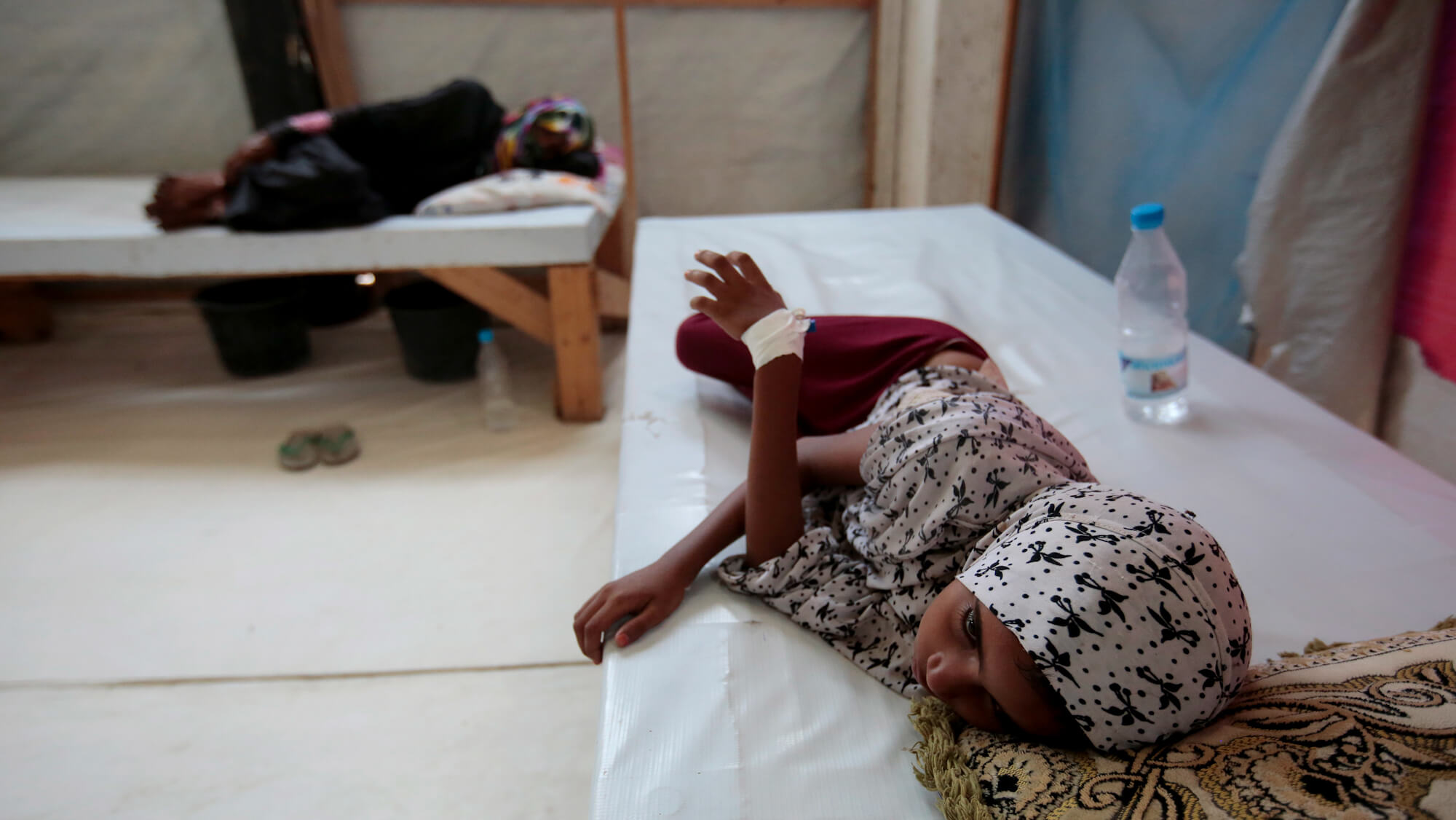
A malnourished girl is treated for a suspected cholera infection at a hospital in Hodeida, Yemen. Hani Mohammed | AP
Moreover, the coalition has used systematic economic strangulation as a weapon of war — targeting jobs, infrastructure, the agricultural sector and pumping stations, factories, and the provision of basic services. The coalition claims it is targeting economic sites being used for military purposes, which it, therefore, considers legitimate military targets.
But the attack on Hodeida in particular, as well as the blockade and aerial bombing campaign, have created widespread hunger. Yemen was importing more than 70 percent of its food through Hodeida’s port — no other port in the country comes close to being able to handle the amount of cargo and aid that Hodeida can.
Returning to the collapse of the local currency, Saudi Arabia, which is estimated to have spent upwards of $100 billion in its bloody war on Yemen since 2015, said on Tuesday that it will deposit just $200 million in Yemen’s Central Bank to help stem a slide in the riyal. But Yemenis say the need is not for such tokens, but to stop the war, lift the siege, and resume the export of oil and gas.
Moreover, these deposits are often never made or do not reach Yemeni banks. On January 17, 2018, Saudi King Salman said that a deposit of $2 billion would be paid to the Central Bank in Aden. However, the Central Bank did not receive the promised deposit from the Saudis, according to a source at the bank, who confirmed that that failure was among the factors weighing on the Yemeni riyal and causing a general collapse. The Yemeni riyal is the backbone of the country’s economy and it is used to buy everything from spare parts to basic foodstuffs.
Fundamentally, it would not be difficult for ultra-rich countries to end famine in Yemen, especially as they spend millions of dollars daily on airstrikes, rocket attacks, and processing intelligence. Instead, they actively seek to prolong Yemeni suffering for their own political gain, building their greed upon the bones of starving Yemenis.
As a result, residents have flocked to protests across the country, and especially in the south, occupied by Saudi Arabia and the United Arab Emirates (UAE), since September. Photos of coalition leaders and Saudi and UAE flags have been torn and burnt, expressing the boiling anger at the current economic crisis that the coalition’s war has created.
Few options for treatment
Extreme famine broke out two months ago in remote areas throughout Yemen. Walid al-Shamshan, head of the Health Ministry’s nutrition section in Hajjah, said:
Deaths happen in remote villages where people can’t reach the health units. It’s a steady deterioration and it’s scary.”
Like many centers in remote areas, Aslam’s main health center has no pediatricians, electricity, oxygen cylinders or fuel for generators. But worse than that, there is no specialized pediatrics or medical staff. There is also an absence of humanitarian and relief organizations in the directorate, which received large numbers of internally displaced persons from border areas.
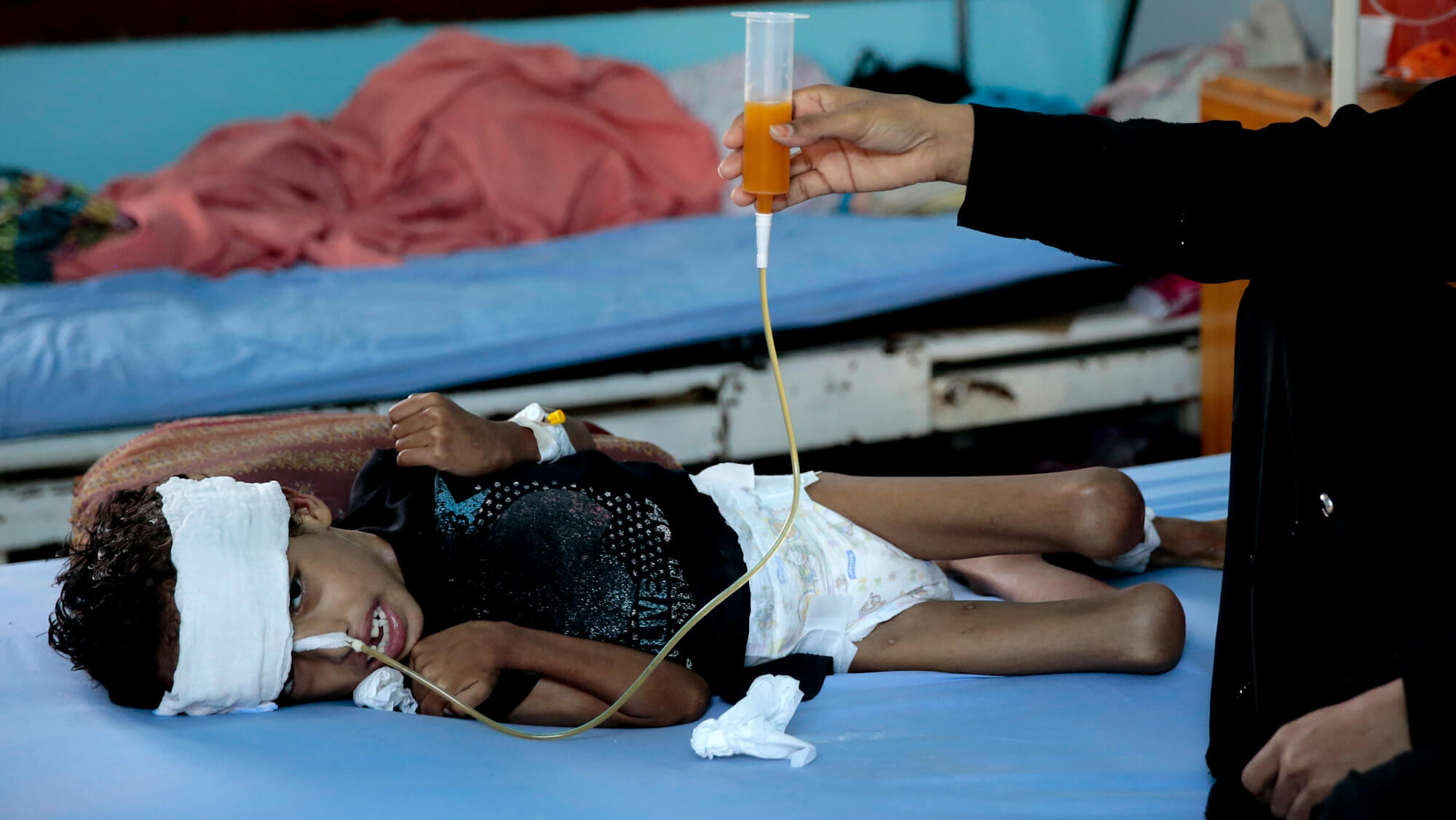
A mother feeds her a malnourished son at a feeding center in a hospital in Hodeidah, Yemen. Hani Mohammed | AP
A worker in Aslam’s health center told MintPress, “We are just nurses, there is no doctor; we do not know how to treat the patients.”
Moreover, a ruinous blockade of Yemen’s ports has depleted the country’s supplies of life-saving medicine. The hospitals that have not been reduced to rubble are barely functioning; doctors have not been paid, and power cuts are frequent.
Yemen is not on the verge of famine; famine actually exists
Even prior to the outbreak of famine in Aslam, Lowcock admitted to the Security Council last month that the UN is losing the fight against famine in Yemen.
This fact, which is still ignored by the wider world, was underlined by the World Food Program (WFP) when it warned Thursday that there very well could be famine in remote areas of the country, where the UN’s food agency does not have access. Now the dearth is also in cities like Hodeida, Lahj, Amran, and Abbian provinces, meaning that famine is no longer a phenomenon exclusive to remote areas. While starvation is not yet as extreme in the cities as it is in villages, that does not mean it could not reach the same point in the days to come.
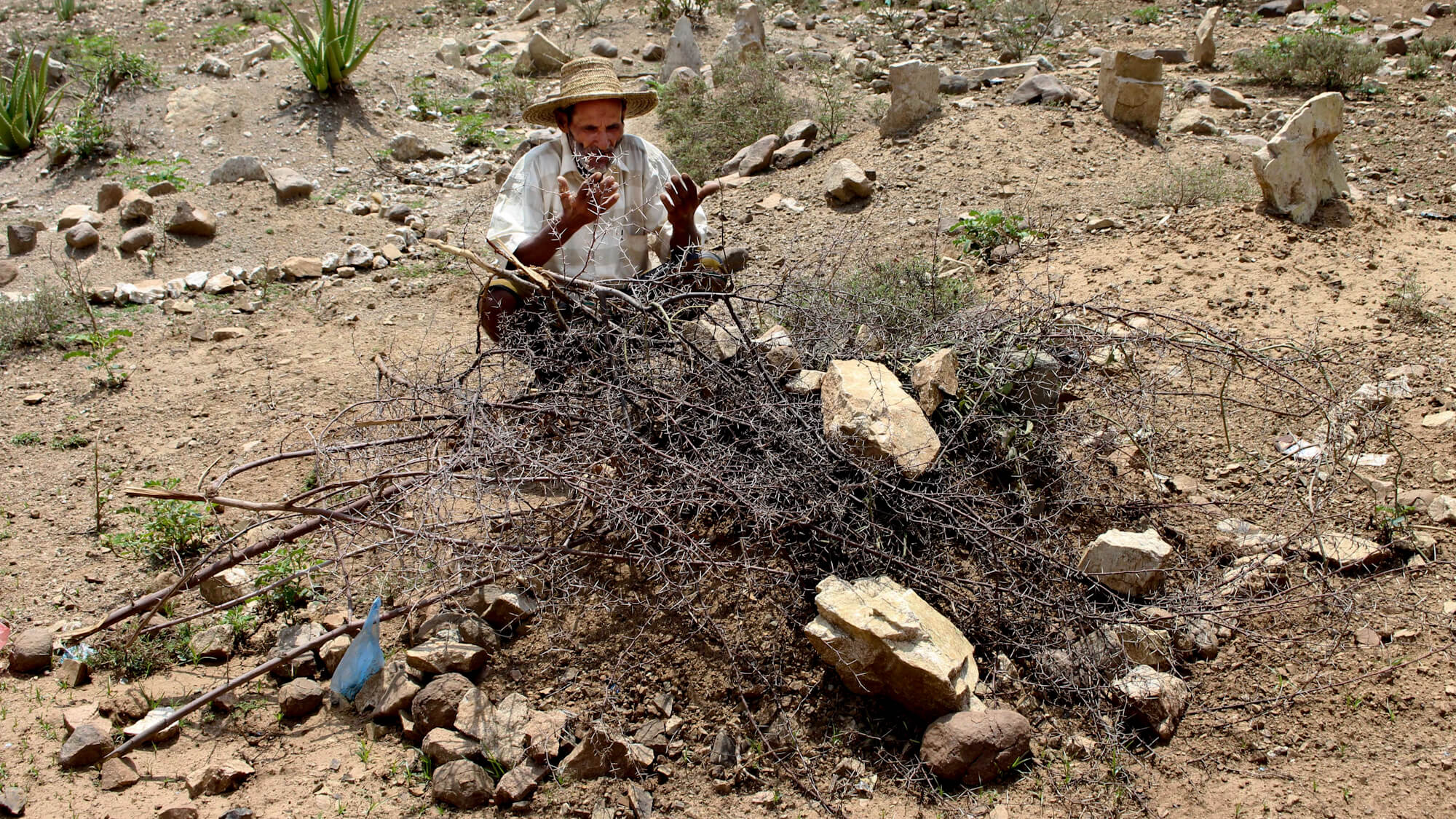
Shouib Sakaf the father of 3-year-old Zaifa Shouib who died of severe acute malnutrition, prays in front of her grave in Hajjah, Yemen, Sept. 22, 2018. Hammadi Issa |AP
Whatever the extent of famine, Yemen is in a multi-faceted disaster on all fronts, WFP’s Executive Director David Beasley told reporters at a closed briefing during the UN General Assembly in New York City, “Yemen is undeniably the world’s worst humanitarian crisis by far,” he added, “I don’t see any light at the end of the tunnel right now.”
In one of thousands of cases, two-year-old Hamdan Hajjeb was lucky to survive. He was suffering from a deadly combination of severe malnutrition and diarrhea when he reached al-Sabeen Hospital in Sana’a, which is supported by Save the Children. His father, Shukri, had braved airstrikes, checkpoints, and shells to get him there from Hodeida.
But Hamdan, as other malnourished children, is far more likely to contract and die of diseases like pneumonia, cholera and malaria than are healthy children. Even where children survive, the effects of malnutrition can be long-term and continue to affect physical and mental development indefinitely throughout their lives.
Top Photo | A doctor shows a photo of Fadl, an 8-month-old Yemeni boy taken in his last days before he starved to death, in this Feb. 10, 2018 photo at a hospital in Mocha, Yemen. Nariman El-Mofty | AP
Ahmed AbdulKareem is a Yemeni journalist. He covers the war in Yemen for MintPress News as well as local Yemeni media.
The post As Millions Starve, Many Still Speak of a Yemen “On the Brink of Famine” appeared first on MintPress News.
